Music intervals are the distance between two notes and their relationship to each other.
This basically means how far one note is to the other when being played.
For example, the distance between a C and a D would be a major second. We will go over what this means in a minute.
Why in the world would you want to know this? Because knowing music intervals and being able to recognize them when you hear and see them will help you tremendously when playing an instrument.
Say for instance you are playing a song by ear and you are trying to quickly play the melody. If you know your intervals you’ll be able to play it back easily.
Types of Intervals
Threre are two types of intervals in the music world. Harmonic and Melodic.
Harmonic
A Harmonic interval is when the notes are played at the same time. Like when a choir sings they are singing harmony. So when these notes are played together they are harmonic intervals.
Melodic
Melodic intervals are when the notes are played separately or one after the other.
Think of the tune of your favorite song. How does the singer change from one note to the next. This is a melodic interval.
These types of intervals are going to be te beginning part of your ear training experience. Once you get better you will be able to recognize harmonic intervals.
Naming the Distance
Naming each one of these intervals is important so you can associate a name with each of them in order to communicate them with others you are playing with and also so you can have anther method of recognition.
Major and Minor Second
Each interval will have a starting note and an ending note. the first note is going to be known as the root note.
So lets start with C and assume we are in the key of C. C will be our reference note for naming all of the intervals.
So start with C and go up to the next note in the key of C which is D. (If you need help with keys go to my lessons on key signatures.)
You have gone up to the second note which is called a major second. Which is two half steps away from C. Pretty easy right.
But what about the black note in between the the C and the D? Take a look at the keyboard and you will see what I mean.
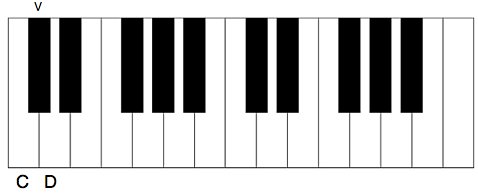
That black note in between the C and the D is called a Minor Second or one half step away from C. Minor Seconds are 1 half step away from the root note and Major Seconds are 2 half steps away.
An easy way to remember the difference between a major and a minor is if the note belongs in the key then it is a major, if it doesn’t then its a minor.
D belongs in the key of C so it s a Major Second. This black note (Db/C#) does not so its a Minor Second.
Major and Minor Third
The same concept goes for the the next note intervals. The distance from the C to the E is four half steps which is called a Major Third. But there is another black note directly to the left of the E. You guessed it! The Eb/D# note is a Minor Third or three half steps.
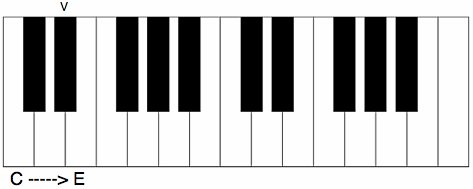
Perfect Fourth
The next note in the scale of C is the F. So if you count up the scale of C the F would be the fourth note in the scale. This interval is called a Perfect Fourth.
Perfect music intervals cannot be major or minor but it can be augmented or diminished.
When a note is augmented it means that a perfect note has been raised one half step. A note that is diminished it means that a perfect note has been lowered one half step.
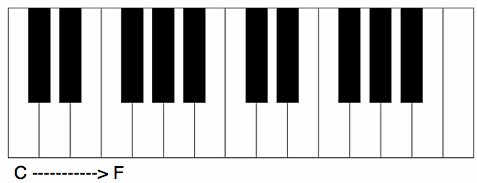
Perfect Fifth
A perfect fifth is the fifth note in the scale or seven half steps.
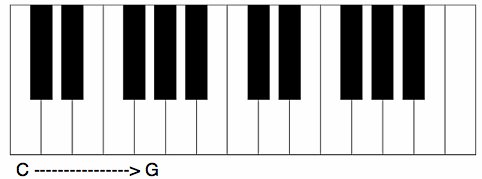
Augmented Fourth/ Diminished Fifth
So we have named all of the music intervals so far except for the F#/Gb.
Based on what you’ve learned so far you would think to call this a minor fifth right?
If you remember, we learned that perfect music intervals cannot be minored it can only be augmented or diminished.
With the definition of augmented and diminished music intervals this tells us that this interval is going to be called either a diminished fifth or an augmented fourth. You can call it either one. It is called an augmented fourth because it is raised one half step from the fourth. The same goes for the diminished fifth. It is lowered one half step from the fifth so it is called a diminished fifth.
Minor and Major Sixth
The distance between the C and A is going to be called a Major Sixth. This is because if you count up the notes in the key of C you will notice that the A is the sixth note in the scale.
What about the note to the left of the A? You guessed it. Its the Minor Sixth.
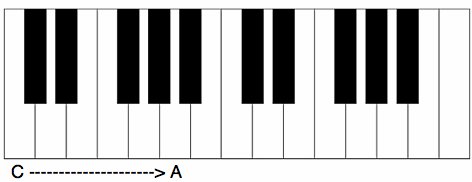
Minor and Major Seventh
The same thing goes for the Seventh note in the key of C. The B is called the Major Seventh and the note to the left of the B is called the Minor Seventh.
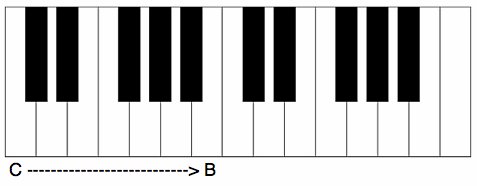
Unison
We have gone all the way up the B and now get to another C. When you play two notes that are the same this is called Unison.
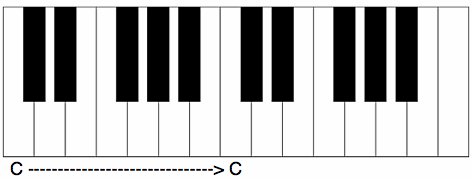
This means the distance from two identical notes is called Unison.
Naming the Half Steps
I have explained all of this in a way that you might understand it better. But to really understand the theory behind music intervals you have to understand the number of half steps it takes to get to that note.
So here is a list of the number of half steps it takes to form that interval.
- 1 half step = minor second
- 2 half steps = major second
- 3 half steps = minor third
- 4 half steps = major third
- 5 half steps = perfect fourth
- 6 half steps = augmented fourth/ diminished fifth
- 7 half steps = perfect fifth
- 8 half steps = minor sixth
- 9 half steps = major sixth
- 10 half steps = minor seventh
- 11 half steps = major seventh

Conclusion
The thing you must know about intervals is that there is a set of intervals for each key signature.
We worked in the key of C in this example. But if you are playing in another key like Ab then you must know the intervals for that key.
You just do the same thing we did before with that key. Count up the notes in the scale to find the interval.
Now that you know the theory behind Music Intervals you can now start to practice using them. Once you have mastered these intervals it will help you to play music better by ear and know how a song goes just by hearing it. To help you with your ear training you can go to my section on Interval Recognition (coming soon!) to help you to have a better ear for music.
Go From Music Intervals Back to Piano Theory
Back to Home Page
